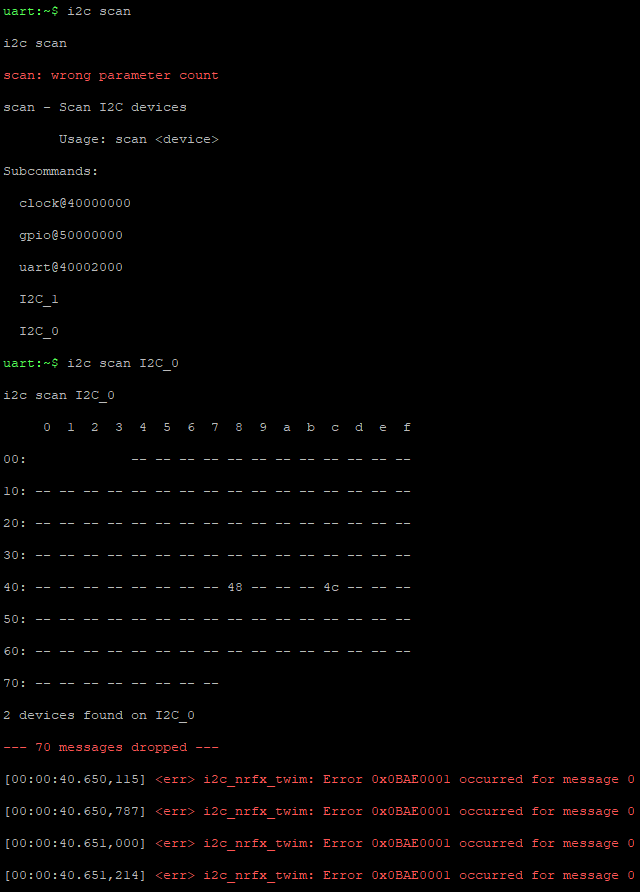Hello,
I am trying to access I2C device - onboard Holyiot 21061 board. When setting in DT the compatibility to "nordic,nrf-twim" - I2C isn't able to communicate with a device. I do not have an analyser, but all APIs return -EIO.
In the output of I2C shell "i2c scan" command - no devices are found. But when I change the compatibility to "nordic, nr-twi" (w/o trailing "m") - everything works OK.
/dts-v1/;
#include <nordic/nrf52832_qfaa.dtsi>
#include "holyiot_21061-pinctrl.dtsi"
/ {
model = "Holyiot 21061";
compatible = "holyiot,21061";
chosen {
zephyr,console = &uart0;
zephyr,shell-uart = &uart0;
zephyr,uart-mcumgr = &uart0;
zephyr,bt-mon-uart = &uart0;
zephyr,bt-c2h-uart = &uart0;
zephyr,sram = &sram0;
zephyr,flash = &flash0;
zephyr,code-partition = &slot0_partition;
};
leds {
compatible = "gpio-leds";
led0: led_0 {
gpios = <&gpio0 0 GPIO_ACTIVE_HIGH>;
label = "LED0";
};
led1: led_1 {
gpios = <&gpio0 1 GPIO_ACTIVE_HIGH>;
label = "LED1";
};
led2: led_2 {
gpios = <&gpio0 2 GPIO_ACTIVE_HIGH>;
label = "LED2";
};
};
/* These aliases are provided for compatibility with samples */
aliases {
ledr = &led0;
ledg = &led1;
ledb = &led2;
watchdog0 = &wdt0;
};
};
&gpio0 {
status = "okay";
pin_as_output_low {
gpio-hog;
gpios = <30 GPIO_ACTIVE_HIGH>, <1 GPIO_ACTIVE_HIGH>, <27 GPIO_ACTIVE_HIGH>; // VDD_EN
output-low; /* or output-low */
line-name = "pin_as_output_low";
};
pin_as_output_high {
gpio-hog;
gpios = <5 GPIO_ACTIVE_HIGH>; // Ad0 & CS
output-high; /* or output-low */
line-name = "pin_as_output_high";
};
};
&gpiote {
status = "okay";
};
&flash0 {
partitions {
compatible = "fixed-partitions";
#address-cells = <1>;
#size-cells = <1>;
boot_partition: partition@0 {
label = "mcuboot";
reg = <0x00000000 0xc000>;
};
slot0_partition: partition@c000 {
label = "image-0";
reg = <0x0000C000 0x37000>;
};
slot1_partition: partition@43000 {
label = "image-1";
reg = <0x00043000 0x37000>;
};
storage_partition: partition@7a000 {
label = "storage";
reg = <0x0007a000 0x00006000>;
};
};
};
i2c0: &i2c0 {
status = "okay";
compatible = "nordic,nrf-twi";
pinctrl-names = "default", "sleep";
pinctrl-0 = <&i2c0_default>;
pinctrl-1 = <&i2c0_sleep>;
label = "I2C_0";
};
i2c1: &i2c1 {
status = "okay";
compatible = "nordic,nrf-twi";
pinctrl-names = "default", "sleep";
pinctrl-0 = <&i2c1_default>;
pinctrl-1 = <&i2c1_sleep>;
label = "I2C_1";
};
&pinctrl {
i2c0_default: i2c0_default {
group1 {
psels = <NRF_PSEL(TWIM_SDA, 0, 3)>,
<NRF_PSEL(TWIM_SCL, 0, 4)>;
};
};
i2c0_sleep: i2c0_sleep {
group1 {
psels = <NRF_PSEL(TWIM_SDA, 0, 3)>,
<NRF_PSEL(TWIM_SCL, 0, 4)>;
low-power-enable;
};
};
i2c1_default: i2c1_default {
group1 {
psels = <NRF_PSEL(TWIM_SDA, 0, 26)>,
<NRF_PSEL(TWIM_SCL, 0, 25)>;
};
};
i2c1_sleep: i2c1_sleep {
group1 {
psels = <NRF_PSEL(TWIM_SDA, 0, 26)>,
<NRF_PSEL(TWIM_SCL, 0, 25)>;
low-power-enable;
};
};
};
CONFIG_GPIO=y CONFIG_GPIO_HOGS=y CONFIG_SHELL=y CONFIG_SHELL_BACKEND_RTT=y # choose RTT console CONFIG_USE_SEGGER_RTT=y CONFIG_CONSOLE=y CONFIG_RTT_CONSOLE=y # General config CONFIG_LOG=y CONFIG_LOG_PRINTK=y CONFIG_I2C=y CONFIG_NRFX_GPIOTE=y CONFIG_I2C_NRFX=y
Please advise (main() function is just an endless loop of k_msleep(1000))



